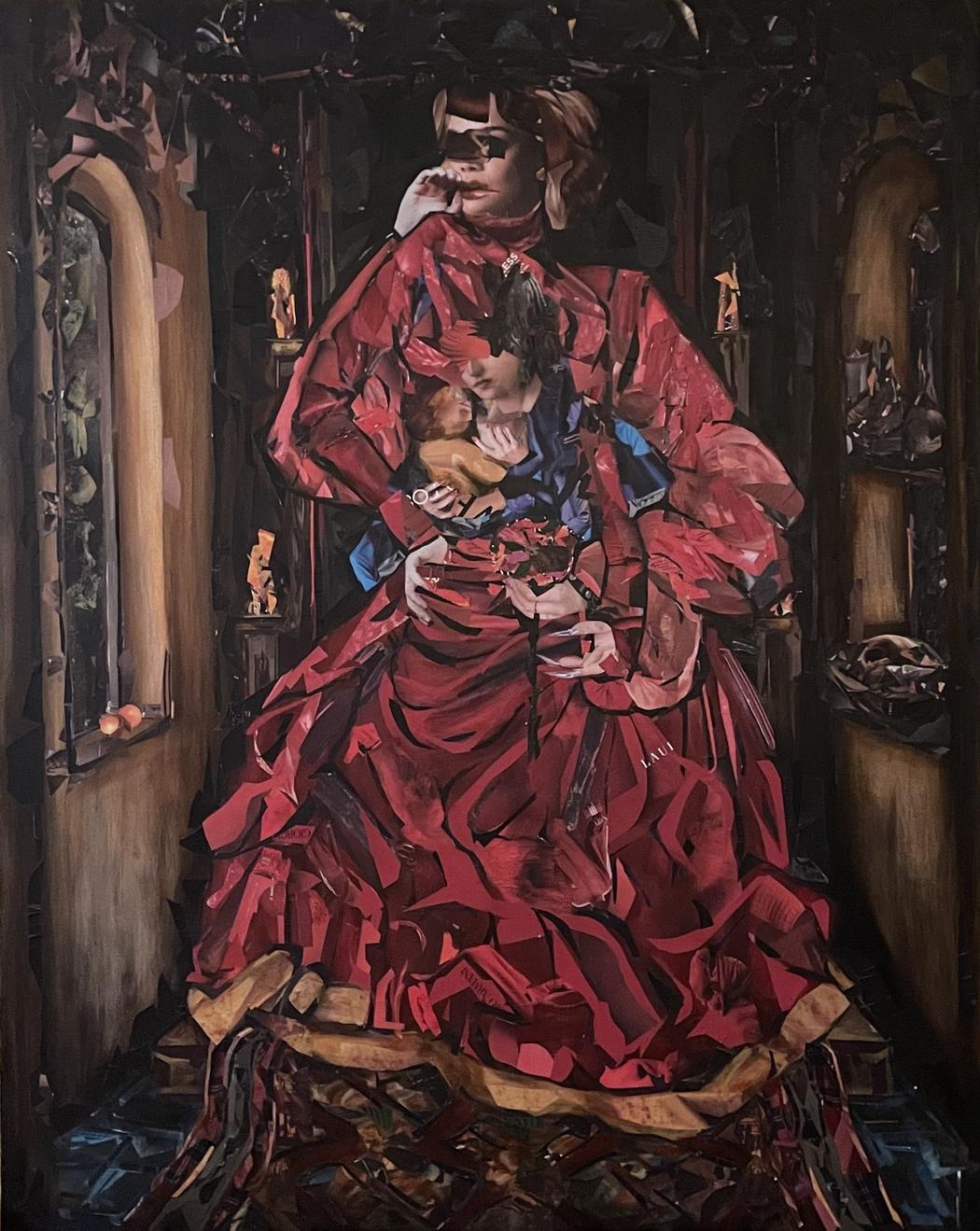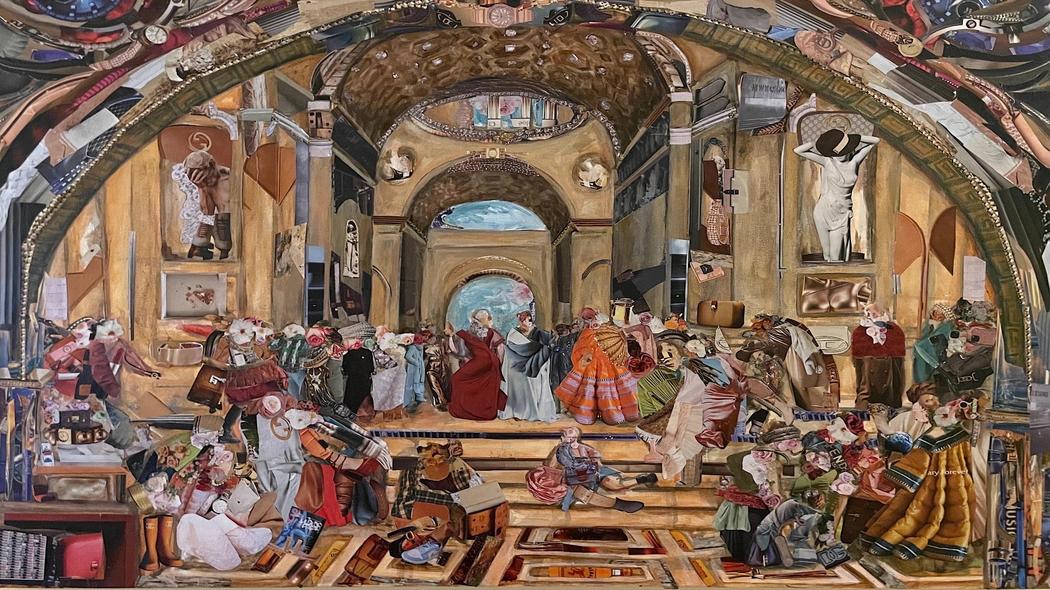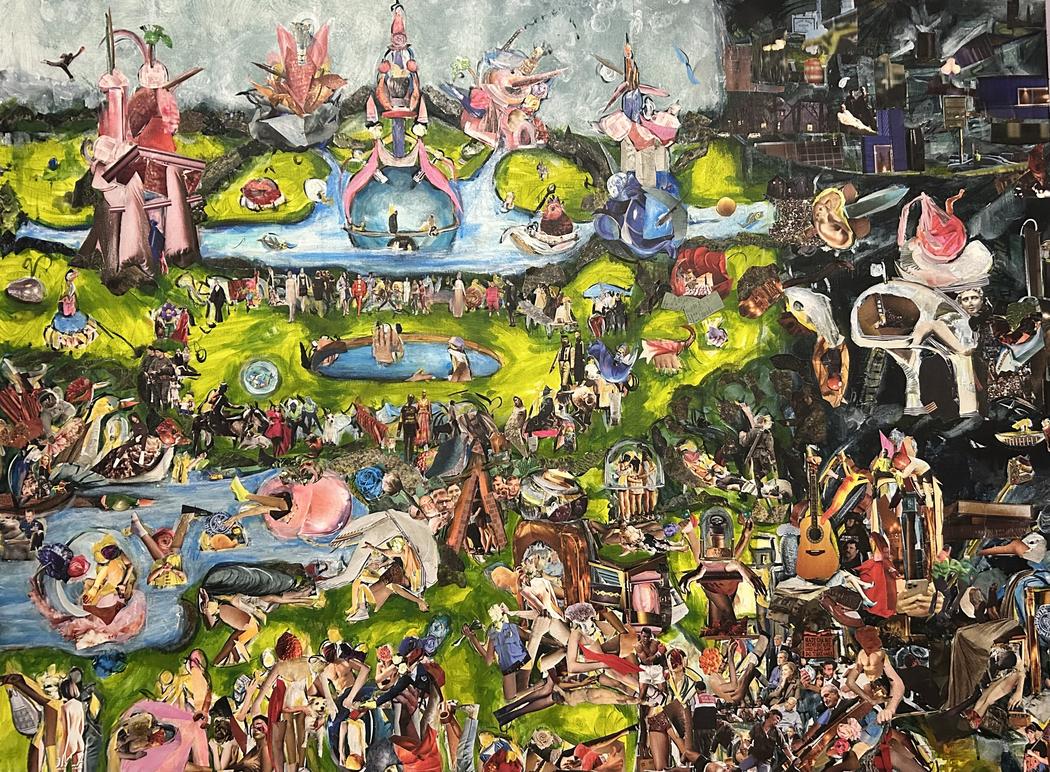Brenna Tomas
Where do you live: Sault Ste. Marie, Ontario
Your education: Master of Education (Teaching and Learning) – University of Ottawa, 2021–2022 · Bachelor of Fine Arts (Art History and Studio Arts, with Distinction) – Concordia University, 2018–2020 · Diploma in Recreation Therapy – Canadore College, 2008–2010
Describe your art in three words: Introspective · Layered · Resilient
Your discipline: Multimedia Visual Art – combining abstract expressionism, collage, and found imagery with classical influences from Renaissance art and contemporary feminist critique.
Website | Instagram
Your artistic and academic background spans art, education, and community work. How do these different fields inform your creative practice today?
I could be described as non-traditional, eccentric, or unconventional, traits that stem from a kind of rebellion against my upbringing in a small town and within a nuclear family structure. Because I understand both ends of that spectrum, my practice is simultaneously chaotic and meticulous. I am constantly interpreting the world against an idealized version of “normal”, a concept that has come to feel synonymous with comfort, perfection, and balance. I critique this ideal through my process and thematic focus in my large-scale pieces.
I explore themes rooted in art history, education, and community by interrogating what we’ve come to accept as conventional. This includes questioning traditional imagery from the canon, examining ethical and philosophical norms, critiquing research methods in educational systems, and exploring the psychological dimensions of human experience. I work primarily with acrylic washes, intentionally leaving visible brushstrokes as a way to emphasize human presence and embrace imperfection. I incorporate found imagery and textures from photography to create tension between the old and the new, drawing attention to the interplay between authenticity and modernity. My studio practice is a way of exploring the authority of the “objective few” versus the lived experience of the collective. “Normal,” it seems, is a concept many strive toward, yet one that is persistently out of reach. My work is a space to find comfort in the unusual and challenge the notion of what is now considered the “new normal.”
 Brenna Tomas | Lady In Red
Brenna Tomas | Lady In Red
The exhibition to (re)cognize explores how history and media shape our perceptions of identity and power. What inspired you to begin this particular investigation?
This investigation began during a period when I was personally struggling to adapt to a new version of “normal”, throughout and after the pandemic. It felt as though we had all been asked to give up a part of ourselves, and in doing so, many of us were pushed far beyond any sense of comfort or familiarity. During that time, I began to question the foundations of my identity and to examine who, or what, held power over it.
That questioning led to a deeper engagement with perception and cognition. I began to re-examine the systems and stories around me, shifting my artistic focus from purely aesthetic concerns to prioritizing personal meaning and communication. It was a time of loss and redefinition, and the only way forward was to rebuild understanding from the inside out.
 Brenna Tomas | Modern School Of Thought
Brenna Tomas | Modern School Of Thought
Many of your works reimagine classical imagery through a contemporary feminist lens. How do you approach this dialogue between tradition and critique?
I approach this dialogue by using my background in art history and critical theory to reinterpret classical imagery through the lens of my own lived experience, one that is undeniably modern and feminist. This lens isn’t something I apply externally; it’s intrinsic to how I see the world. My work questions the visual and cultural conventions we often take for granted—particularly those that have historically excluded or misrepresented marginalized identities.
I challenge traditional narratives by layering contemporary imagery over familiar historical compositions, inserting alternative perspectives and voices. I’ve studied how individuals internalize collective narratives and how systems shape those perceptions. My work uses these investigations to both critique and expand the visual languages we’ve inherited.
 Brenna Tomas | Paradise Reconsidered
Brenna Tomas | Paradise Reconsidered
You describe art as a “means of inquiry.” Could you elaborate on how the process of creating helps you understand human experience?
Absolutely. I believe art is a way of asking questions that don’t have clear answers. Throughout my life, moments of insight, however small, have triggered meaningful change. My practice helps me understand not only my own human experience but also how I fit into the broader fabric of collective life.
I often begin with found imagery, photographs, magazines, printed materials, and build visual correlations between them as I work. This method allows me to move intuitively, uncovering patterns, themes, and contradictions. These discoveries teach me about myself, but also about how we, as a society, interact with ideas. By engaging with shared symbols and narratives, my work creates space to meditate on collective memory, group behavior, and modern frameworks for thinking and learning.
How has your experience as a mother influenced your understanding of resilience and identity in your art?
Motherhood has taught me to embrace the mess; mistakes, marks, imperfections, as essential parts of both art and life. My practice reflects that ethos. I’ve learned to find beauty in what’s incomplete or chaotic, because it’s often those elements that make something feel real and whole.
Motherhood demands constant adaptation. It’s filled with uncertainty, emotion, and transformation. In raising children, I’ve had to learn how to stay grounded amidst flux—and how to see each moment, even the difficult ones, as contributing to something larger and more meaningful. It’s shown me how identity is shaped not just by what we choose, but also by how we respond to change. That sense of resilience, of building something meaningful out of disarray, infuses my work.
 Brenna Tomas | Off With His Head
Brenna Tomas | Off With His Head
Your practice blends written and visual languages. What role does writing play in your creative process?
Writing is essential to how I process meaning. My visual work can often be ambiguous, open to a range of interpretations based on the viewer’s perspective. Writing helps me articulate the personal reasoning behind certain choices, but I also use it as a way to expand and complicate meaning, not limit it.
I’m interested in the moment where visual language disrupts what has been expected or written. Sometimes, a small shift in perception can trigger an entirely new way of seeing. My writing is a way to navigate those shifts, to explore how our understanding is shaped by language, and how easily it can be reoriented. I accept that miscommunication is part of being human, and I see both visual and written language as opportunities to engage with that tension.
 Brenna Tomas | Step Up
Brenna Tomas | Step Up
What artistic or literary influences have shaped your current practice?
My work is grounded in classical art history, but I use found imagery to recontextualize it, layering older visual traditions with modern perspectives to create new semiotic readings. I’m particularly influenced by artists like Penny Slinger, whose embodied collage work helped me understand how to use the female experience as both subject and lens.
Theoretically, Walter Benjamin’s The Work of Art in the Age of Mechanical Reproduction shapes my thinking around authenticity, reproduction, and cultural value. Roland Barthes’ On Interpretation and Jean Baudrillard’s theories also inform how I engage with meaning, representation, and simulation in my compositions.
On a more contemporary note, the work of Chuck Klosterman reminds me that humour, irony, and pop culture can be powerful tools for understanding human behaviour. His writing helps me think critically, but accessibly, about how people engage with big ideas in everyday life.


Leave a Reply